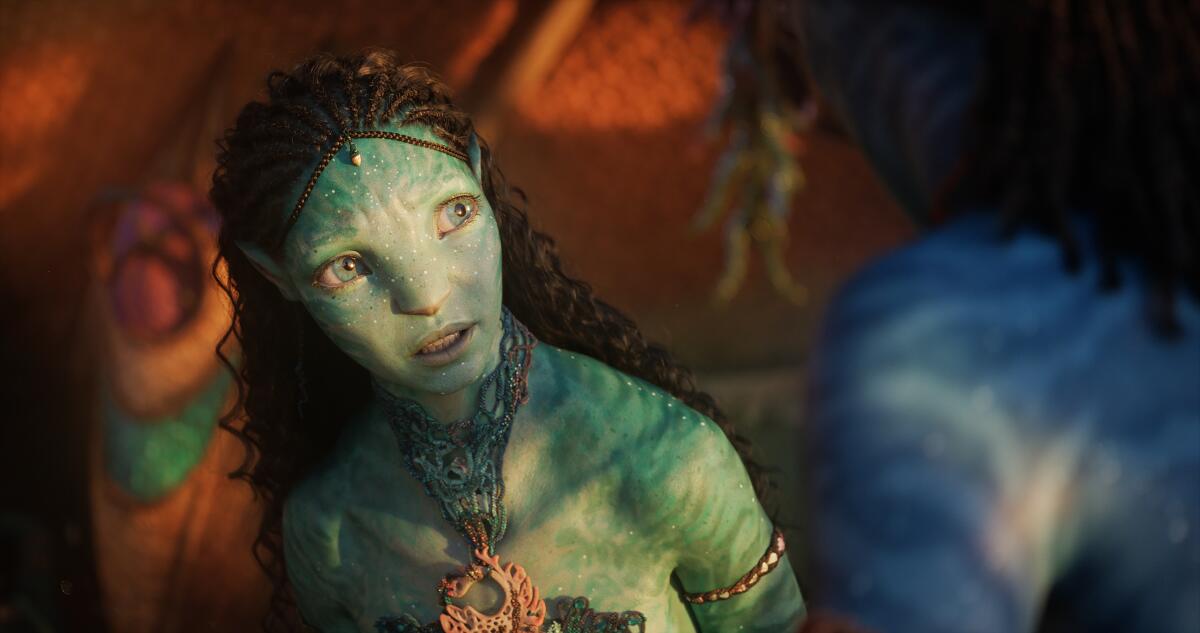Hollywoodâs 2022 box office reality check: Not enough hits and a movie shortage

It was the year that the box office recovery from the COVID-19 catastrophe began to take shape.
Blockbusters hit the big screen, led by Tom Cruise, giant people-eating dinosaurs and James Cameronâs tall, blue Naâvi. One year after Warner Bros. sent its entire release slate to HBO Max and cinemas simultaneously, the Burbank studioâs movie posters boasted âonly in theatersâ like old times. In a show of confidence, the head of the worldâs biggest theater chain rolled down the streets of Pasadena in a Rose Parade float.
But it wasnât enough.
The year is expected to end with about $7.35 billion in ticket sales from the U.S. and Canada, according to analysts and studio estimates, down 35% from the pre-pandemic year of 2019.
When the hits came, they reminded audiences and studio executives of the good old days, proving that audiences want to go back to certain movies in droves.
There just werenât many movies of that caliber.
Only three 2022 pictures will have grossed more than $1 billion worldwide, assuming âAvatar: The Way of Waterâ reaches that milestone. The mega-budget movie is expected to join âTop Gun: Maverick,â the highest-grossing film of the year ($1.49 billion), and âJurassic World Dominionâ (almost exactly $1 billion). In 2019, nine movies joined the billion-dollar club, most of them produced by Disney.
The primary culprit, according to theater owners and studio executives: a persistent movie shortage.
U.S. cinemas received 38 fewer wide-release movies as of Dec. 25 this year compared with the same point in 2019, according to Comscore. A wide-release plays on 1,800 screens or more.
âYouâre off 30-something percent and youâve got 30% less movies, right?â said Brian Robbins, president and chief executive of Paramount Pictures. âThe math kind of works.â
With such a thin slate, the box office became increasingly reliant on the home runs, and there werenât enough of what studio executives call singles, doubles and triples â the kinds of mid-budget films that sustained theaters year-round.
The top 10 movies this year are expected to account for more than half of the industryâs total box office. In the years before COVID-19, the 10 highest-grossing movies took up between 30% and 40% of the annual totals, according to Comscore data.
Multiple factors explain the shortfall in film releases. Some big pictures were pushed to 2023, including Warner Bros.â âShazam! Fury of the Gods.â A backlog at visual effects companies meant that some films couldnât be finished in time and had to find other premiere dates. Some films that in other years might have gone to theaters were instead funneled to streaming services (Pixarâs âTurning Redâ and Disneyâs âHocus Pocus 2â).
Certain movies were released in theaters but hit streamers at the same time, undercutting their grosses (âFirestarter,â âHalloween Endsâ). In a particularly disruptive move, Netflix took Rian Johnsonâs âGlass Onion,â a sequel to a massive hit, âKnives Out,â and yanked it from theaters after a week-long promotional run.
A pair of Disney animated bombs (âLightyear,â âStrange Worldâ) sparked worries that the companyâs streaming strategy had trained loyal fans to look for its movies primarily on Disney+ rather than buy tickets.
And some films just flopped as studios took bets that simply didnât pan out (Focus Featuresâ âThe Northman,â MGMâs âThree Thousand Years of Longingâ).
Finally, many top releases were clumped together within a couple months of one another, resulting in long stretches without any blockbusters.
The first four months of the year were a disaster, thanks to a paucity of major titles. Late spring and early summer came back roaring with âDoctor Strange in the Multiverse of Madness,â âTop Gun: Maverickâ and âJurassic World Dominion.â
And then the late-summer drought hit. After âBullet Trainâ in August and before Warner Bros.â âBlack Adamâ in October, only âSmileâ managed to crack $100 million in domestic sales. The lean times killed whatever momentum the hits had built up.
Comscore senior media analyst Paul Dergarabedian compared the year to a relay race in which an athlete fumbles the baton.
âIf it was just that people didnât want to go back to the movies, then the summer would have sucked too,â Dergarabedian said. âWhat changed was that there were fewer movies, and then this unusual circumstance threw the release calendar into disarray.â
The doldrums hit theater operators hard.
Cineworld, owner of the nationâs second largest theater chain, Regal, filed for bankruptcy in September, citing the weak slate and a heavy debt burden. The stock price of the No. 1 chain, heavily indebted AMC Theatres, plummeted after surging last year as CEO Adam Aron memed his way into retail investorsâ hearts. Shares of AMC have fallen 82% to $4.91 so far this year.
It was hardly all doom and gloom, though. The year demonstrated that releasing good movies in theaters is smart business, as long as they remain in cinemas for multiple weeks before they show up for online rental or streaming.
Starting in 2020, when theaters were closed for months, studios experimented with releasing movies in theaters and online sites at the same time. Same-day streaming cannibalized box office. Sign-ups to streaming platforms surged.
But entertainment companies, other than Netflix, have begun to backtrack on streaming-focused movie strategies.
Wall Street has started to demand profits rather than subscriber numbers at all costs. Warner Bros. Discovery CEO David Zaslav, in contrast with the preceding AT&T regime, has rejected big streaming movies as boondoggles. Paramountâs upcoming comedy â80 for Bradyâ was at first intended for streaming, but is getting a theatrical release instead. Ditto for âMagic Mikeâs Last Dance,â which was planned for HBO Max, but is now set for the big screen next year.
âThey wanted to boost their subscriber numbers while they had a chance,â said Eric Wold, senior analyst at B. Riley Securities. âBut I think weâve seen that that just isnât sustainable, nor can it get a return on a high production-cost film.â
Still, itâs becoming clear that the theatrical window â the gap of time when theaters have sole rights to show movies â has changed for good. Previously, movies waited an average of 72 days before becoming available for digital viewing. Now, studios are holding most films for around 45 days before they hit streaming.
The flexible release patterns are beneficial for studios because they allow them to avoid having to restart marketing campaigns. Theyâre more efficient and give poor-performing movies a better shot at profitability. On the flip side, successful movies can stay for longer. âTop Gun: Maverickâ remained in theaters for more than 90 days before becoming available for home viewing.
âI donât think itâs going to be one-size-fits all,â said Jim Orr, president of domestic distribution for Universal Pictures. âStill, I think some consistency across the windows is a decent thing.â
Studios that held on to their biggest movies to release them in theaters reaped the rewards.
Paramount Pictures enjoyed unusual levels of success in 2022, releasing âJackass Foreverâ and a âScreamâ reboot early in the year, facing minimal competition. The long-awaited âTop Gun: Maverickâ became the yearâs highest-grossing release, with $1.49 billion in ticket sales. âSmile,â a movie that was greenlighted with a straight-to-streaming plan, was flipped to theaters and became a huge hit.
âSometimes I say I feel like weâve been living in a little bit of an alternative movie business reality,â Robbins said.
Universal Pictures put out more movies than any other studio by far â 33 including a couple classic re-releases â and had a remarkably diverse slate that bet on a wide range of genres for various audience demographics.
That paid off in some instances, with winners like Jordan Peeleâs âNope,â Illumination Entertainmentâs âMinions: The Rise of Gruâ and Dreamworks Animationâs âThe Bad Guys.â In other cases, not so much. âShe Saidâ and âBrosâ were among the yearâs biggest flops.
Disney, in contrast to its struggles in animation, did well with superhero titles, taking the current No. 2 and No. 3 spots with âBlack Panther: Wakanda Foreverâ ($421 million domestic) and the âDoctor Strangeâ sequel ($411 million), respectively. Warner Bros. found success with âThe Batmanâ ($401 million) and âElvisâ ($151 million).
The winners and failures defied conventional wisdom about the health of whatever genres went in and out of vogue.
Yes, comedies largely struggled. Mid-budget fare aimed at adults, long a source of angst within studios, fielded several wins, including Sonyâs âThe Woman Kingâ and âWhere the Crawdads Sing.â
Indie art-house labels served up their share of commercial disappointments like âTĂĄrâ and âThe Banshees of Inisherin,â suggesting that serious cinema is a tough sell in an environment that rewards escapism.
But some âspecialtyâ releases fared well, at least those that were entertaining and skewed young, such as Searchlightâs âThe Menuâ and A24âs âEverything Everywhere All at Once.â
âItâs fair to say that itâs probably a little bit more difficult to get certain demographic groups back into theaters,â Orr said. âSome of the adult titles have certainly struggled, but I donât think thatâs always going to be the case. Weâll get to the other side of that.â
Horror had a particularly strong year, with highly profitable releases including âThe Black Phone,â âBarbarianâ and âSmile.â
When people came back to theaters, it was often for a premium experience. Audiences paid up for large format screenings, such as Imax, that make a trip to the movies more of an event. During the opening weekend of âThe Way of Water,â 3-D accounted for 57% of sales. Premium formats and motion seat auditoriums fueled more than 60% of business.
âThereâs no question that when a moviegoer makes an appointment to go to the multiplex to see a specific movie, they want to make sure they get a premium offering like Imax,â said Greg Foster, a movie business consultant and former Imax Entertainment CEO.
But the box office was dominated by big-budget, escapist entertainment based on established film franchises. Every film in the top 10 was a sequel, reboot or part of a larger cinematic universe. The highest-grossing âoriginalâ film was Warner Bros.â opulent music biopic âElvis,â at No. 11.
âDo I feel like thereâs certain parts of the audience that arenât coming back? Sure,â said Robbins. âI think the older audience is still struggling. But that also might be that the product is not there for them.â
Thanksgiving weekend, usually the source of a huge box office bounty, was bereft of compelling new releases, leaving Disney and Marvelâs âBlack Panther: Wakanda Foreverâ to run roughshod over the competition, including fellow Disney release âStrange World.â
Christmas weekend proved to be similarly bare, dampened by wintry weather across much of the U.S. Paramountâs âBabylon,â an audacious ode to old Hollywood from Damien Chazelle, took in just $3.5 million, according to estimates from Comscore released Sunday; Sonyâs âWhitney Houston: I Wanna Dance With Somebody,â notched $5.3 million, and Universal and Dreamworksâ âPuss in Boots: The Last Wishâ earned $11.4 million.
That left âAvatar: The Way of Waterâ a clear path to No. 1 for the second straight week, with a $56-million haul following its $134-million domestic opening. But although analysts and rival studios predict the film will have strong staying power, it remains to be seen whether that will be enough to meet Hollywoodâs (and Cameronâs) sky-high expectations. If the director knows one thing, itâs how to keep audiences awaiting a sequel.
More to Read
Inside the business of entertainment
The Wide Shot brings you news, analysis and insights on everything from streaming wars to production â and what it all means for the future.
You may occasionally receive promotional content from the Los Angeles Times.











